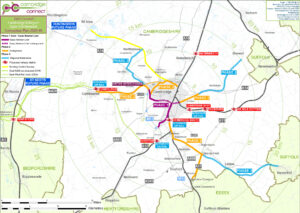In our 2021 revision of the Cambridge Light Rail scheme proposals we considered delivery feasibility over the wider network. Given the scale of the potential network ambition, which could extend to 150 km or more, there was a need for a pragmatic approach focused on delivery. We concluded that delivery of the wider network will take many years, and require substantial resources. While there are real benefits to setting out a regional vision with long-term aspirations, there is also a need for grounded pragmatism in order to deliver.
We placed our wider aspirations into Phase Three, although we are not prescriptive about when, or in what order, these potential extensions could be brought forward. We recognise that at some future stage there will be benefits to including these destinations in a Cambridge Light Rail network. In the current context those aspirations seem still some distance off – although we are certainly open to the options if the will and finance for particular extensions becomes apparent. Two examples are the line to Haverhill, and eastward towards Burwell. There could be a good case for bringing these forward, and indeed Railfuture East Anglia has undertaken feasibility analysis on restoring the line to Haverhill with positive results. That line could be heavy rail, light rail, or a combination using tram-train technology.
The Greater Cambridge Partnership has spent many millions on its schemes to date, but has delivered little to warrant that scale of expenditure. The Combined Authority had an ambition under the former Mayor to create an even grander network than the GCP, with its CAM ‘metro’ extending ~150 km and with ~12 km of complex tunnelling under Cambridge, all within nine years. This latter scheme was dubbed “One CAM”, as a network using autonomous buses, but the technology was only in early trials. We welcomed the decision by Mayor Nik Johnson to cancel this unrealistic and unproven scheme. We’re not short of ambition ourselves, but our plan is based on well-established, successful and proven technology and is much simpler and cheaper to deliver, especially for the short tunnel we propose.
The way forward – light rail
Cambridge Light Rail is a more grounded, proven, and practical way forward. This is focused on delivery of the ‘Isaac Newton’ and ‘Darwin’ Lines in two phases over a period of about ten years. We are not against vision – we have always argued the need for a long term plan. However, it is time for a proven, practical and low risk alternative that is still capable of transforming the Cambridge public transport system. We need to be confident that the system adopted can actually achieve the transformation and the modal shift needed. Substantial modal shift is very unlikely to be realised using buses – history shows that before the Cambridge busways were built buses had ~8% mode share – and today it is less than that. In other words, despite construction of the busways, there has been no overall change in the proportion of people using buses for public transport. There needs to be a genuinely superior option available to change behaviour. Experience from elsewhere shows light rail is a proven, technologically advanced, comparatively low risk option deliverable today that is capable of achieving modal shift on the scale needed.
While buses are also proven and low-risk, the evidence has shown they have very limited capacity to drive transformational change. In other words, further investment in busways simply will not deliver the change we desperately need. It is time to set aside grand ambitions, and focus on practical delivery of transformational change using proven and low-risk solutions. In our view, that means investing in Cambridgeshire Light Rail over a phased longer term plan.
View all Cambridge Light Rail phases …
Download the Cambridgeshire Regional network (Version 12.0, 14 Aug 2024) as pdf (504 KB)








